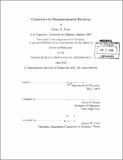| dc.contributor.advisor | Keith A. Nelson. | en_US |
| dc.contributor.author | Arias, Dylan H | en_US |
| dc.contributor.other | Massachusetts Institute of Technology. Department of Chemistry. | en_US |
| dc.date.accessioned | 2013-11-18T19:07:06Z | |
| dc.date.available | 2013-11-18T19:07:06Z | |
| dc.date.copyright | 2013 | en_US |
| dc.date.issued | 2013 | en_US |
| dc.identifier.uri | http://hdl.handle.net/1721.1/82310 | |
| dc.description | Thesis (Ph. D.)--Massachusetts Institute of Technology, Dept. of Chemistry, 2013. | en_US |
| dc.description | Cataloged from PDF version of thesis. | en_US |
| dc.description | Includes bibliographical references (p. 159-184). | en_US |
| dc.description.abstract | Nanotechnology and optoelectronics have the potential to revolutionize the medicine, communications, and energy industries, with applications utilizing nanotechnology beginning to appear. However, there are still fundamental questions about optoelectronic devices incorporating nanotechnology. In particular, how do nanometer-scale materials affect potential functionality, and how can we take advantage of this scale to design nanomaterials for applications? Natural light harvesting systems in bacteria and plants provide exquisite examples of nanomaterial design, featuring remarkably efficient light harvesting antennas. Sunlight absorption first creates excitons. Complex antenna architectures control the excitons, directing them to reaction centers for conversion to chemical energy. Recently, studies found that excitonic interactions play a significant role in controlling antennas' light harvesting abilities, and that coherence may greatly affect energy transport efficiencies. While these studies have propelled our understanding of excitons in these systems, it is desirable to extend our expertise to artificial systems. In this thesis I describe experiments uncovering many fundamental properties of excitons in various nanostructured materials, relating physical structure to excitonic structure and perhaps to subsequent function in an excitonic device. Nonlinear spectroscopy offers distinct possibilities for detailed exploration of excitonic properties and processes in nanomaterials. Transient grating experiments are sensitive to population dynamics and energy transport, while multi-dimensional spectroscopy clearly reveals excitonic interactions, correlations, and coherence. In this thesis, these techniques are performed with a unique multi-dimensional spectrometer using femtosecond pulse shaping. I present results on two classes of artificial nanostructures: supramolecular J-aggregates and semiconductor quantum wells. In J-aggregate thin films I determined that coherence is controlled by thermal dephasing rather than film inhomogeneities, even at cryogenic temperatures. Tubular J-aggregates in solution undergo morphological rearrangement while maintaining a common sub-unit that remains relatively intact both structurally and excitonically. In semiconductor quantum wells, many-body correlations among excitons were shown to decay on the timescale picoseconds, depending on the exciton density and therefore revealing of high-order correlations. These insights into coherence and excitonic structure are important in determining the origin and strength of coherence in excitonic systems, potentially leading toward methods to alter or control exciton dynamics and toward possible novel application of coherence in optoelectronic devices. | en_US |
| dc.description.statementofresponsibility | by Dylan H. Arias. | en_US |
| dc.format.extent | 184 p. | en_US |
| dc.language.iso | eng | en_US |
| dc.publisher | Massachusetts Institute of Technology | en_US |
| dc.rights | M.I.T. theses are protected by
copyright. They may be viewed from this source for any purpose, but
reproduction or distribution in any format is prohibited without written
permission. See provided URL for inquiries about permission. | en_US |
| dc.rights.uri | http://dspace.mit.edu/handle/1721.1/7582 | en_US |
| dc.subject | Chemistry. | en_US |
| dc.title | Coherence in nanostructured excitons | en_US |
| dc.type | Thesis | en_US |
| dc.description.degree | Ph.D. | en_US |
| dc.contributor.department | Massachusetts Institute of Technology. Department of Chemistry | |
| dc.identifier.oclc | 861595301 | en_US |
